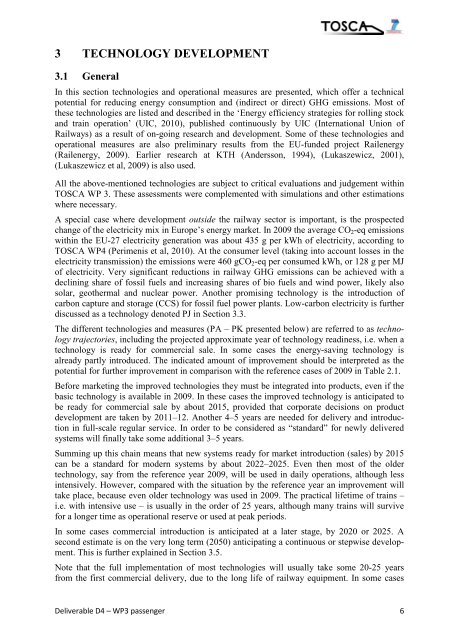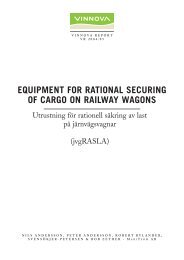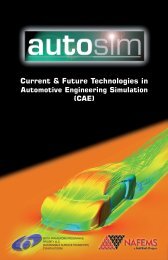WP3: Rail Passenger Transport - TOSCA Project
WP3: Rail Passenger Transport - TOSCA Project
WP3: Rail Passenger Transport - TOSCA Project
Create successful ePaper yourself
Turn your PDF publications into a flip-book with our unique Google optimized e-Paper software.
3 TECHNOLOGY DEVELOPMENT<br />
3.1 General<br />
In this section technologies and operational measures are presented, which offer a technical<br />
potential for reducing energy consumption and (indirect or direct) GHG emissions. Most of<br />
these technologies are listed and described in the ‘Energy efficiency strategies for rolling stock<br />
and train operation’ (UIC, 2010), published continuously by UIC (International Union of<br />
<strong>Rail</strong>ways) as a result of on-going research and development. Some of these technologies and<br />
operational measures are also preliminary results from the EU-funded project <strong>Rail</strong>energy<br />
(<strong>Rail</strong>energy, 2009). Earlier research at KTH (Andersson, 1994), (Lukaszewicz, 2001),<br />
(Lukaszewicz et al, 2009) is also used.<br />
All the above-mentioned technologies are subject to critical evaluations and judgement within<br />
<strong>TOSCA</strong> WP 3. These assessments were complemented with simulations and other estimations<br />
where necessary.<br />
A special case where development outside the railway sector is important, is the prospected<br />
change of the electricity mix in Europe’s energy market. In 2009 the average CO 2 -eq emissions<br />
within the EU-27 electricity generation was about 435 g per kWh of electricity, according to<br />
<strong>TOSCA</strong> WP4 (Perimenis et al, 2010). At the consumer level (taking into account losses in the<br />
electricity transmission) the emissions were 460 gCO 2 -eq per consumed kWh, or 128 g per MJ<br />
of electricity. Very significant reductions in railway GHG emissions can be achieved with a<br />
declining share of fossil fuels and increasing shares of bio fuels and wind power, likely also<br />
solar, geothermal and nuclear power. Another promising technology is the introduction of<br />
carbon capture and storage (CCS) for fossil fuel power plants. Low-carbon electricity is further<br />
discussed as a technology denoted PJ in Section 3.3.<br />
The different technologies and measures (PA – PK presented below) are referred to as technology<br />
trajectories, including the projected approximate year of technology readiness, i.e. when a<br />
technology is ready for commercial sale. In some cases the energy-saving technology is<br />
already partly introduced. The indicated amount of improvement should be interpreted as the<br />
potential for further improvement in comparison with the reference cases of 2009 in Table 2.1.<br />
Before marketing the improved technologies they must be integrated into products, even if the<br />
basic technology is available in 2009. In these cases the improved technology is anticipated to<br />
be ready for commercial sale by about 2015, provided that corporate decisions on product<br />
development are taken by 2011–12. Another 4–5 years are needed for delivery and introduction<br />
in full-scale regular service. In order to be considered as “standard” for newly delivered<br />
systems will finally take some additional 3–5 years.<br />
Summing up this chain means that new systems ready for market introduction (sales) by 2015<br />
can be a standard for modern systems by about 2022–2025. Even then most of the older<br />
technology, say from the reference year 2009, will be used in daily operations, although less<br />
intensively. However, compared with the situation by the reference year an improvement will<br />
take place, because even older technology was used in 2009. The practical lifetime of trains –<br />
i.e. with intensive use – is usually in the order of 25 years, although many trains will survive<br />
for a longer time as operational reserve or used at peak periods.<br />
In some cases commercial introduction is anticipated at a later stage, by 2020 or 2025. A<br />
second estimate is on the very long term (2050) anticipating a continuous or stepwise development.<br />
This is further explained in Section 3.5.<br />
Note that the full implementation of most technologies will usually take some 20-25 years<br />
from the first commercial delivery, due to the long life of railway equipment. In some cases<br />
Deliverable D4 – <strong>WP3</strong> passenger 6
















